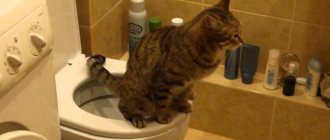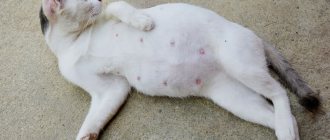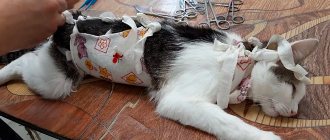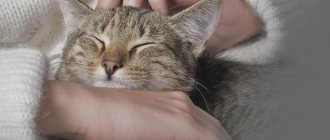The genital organs in cats are organs that produce germ cells, which excrete sexual products and are the site of fertilization and development of the embryo.
The genitals form the reproductive or reproductive system of cats.
Cats, like all mammals, have two sexes - male and female, whose genital organs are different.
Cat genitals
The cat's penis is located below the scrotum. Most of the cat's penis is covered with small outgrowths in the form of keratinized spines; their number can vary from 100 to 200.
Kittens have a scrotum from birth, and when they are three and a half months old, their testicles are already developed enough to produce the male hormone, testosterone. This hormone stimulates the growth of spines on the penis, which reach their maximum size when kittens are six to seven months old. Two to four months after castration of the cat, these keratinized spines begin to disappear, as the source of hormone production itself disappears. At the age of seven months, the testes of kittens can already produce sperm that can fertilize the eggs of full-fledged cats during estrus.
Although the actions of small kittens from about four months contain elements of sexual play (climbing up, straddling a play partner, thrusting with the pelvis, squeezing the partner’s neck with their teeth), they cannot perform full sexual intercourse with the insertion of the penis into the cat’s vagina until they are seven months old. An adult healthy cat is capable of mating with a female cat throughout its life.
Basic information
This is the name for inflammation of the foreskin and glans penis . Animals of all ages are susceptible; all non-castrated cats are at risk (the latter get sick several times less often). Predisposing factors and immediate causes are the following pathologies of the reproductive system:
- Orchitis.
- Phimosis.
- Paraphimosis.
- Cryptorchidism.
- Degenerative lesions of the testes.
- Testicular tumors (not necessarily malignant).
- Prostatitis.
Note that in this case, inflammation of the foreskin does not always have an infectious etiology ; sometimes pathogenic microflora has nothing to do with it. It happens that pathology develops after exposure to some irritating substances, including some types of household chemicals. Sometimes such an “intimate” problem is caused by a sudden change in care products (shampoos, etc.) after the use of certain medications (for example, drops against ticks and fleas).
With balanoposthitis, the head and foreskin become very red, swollen, and a greenish-yellow coating of purulent exudate appears on the affected tissues. In general, a small amount of plaque on the genitals is not a sign of pathology, but when there is a lot of it, you should immediately show your pet to a veterinarian.
Puberty of a cat
As soon as the testes develop and begin to produce the hormone testosterone, we can talk about the onset of puberty in the cat, which is manifested in certain behavior - a tendency to wander, increased aggressiveness towards other cats, splashing urine. His urine contains strong-smelling substances, so-called ferromones, through which the cat seeks to attract a cat in heat.
Under the influence of testosterone, the appearance of the cat changes: the size of the head increases compared to the rest of the body, the jaws are sharply defined, the body becomes thin and muscular, while cats during puberty acquire rounded body contours due to the beginning of fat deposition.
During the entire mating season (from January to October), the territory controlled by the cat increases depending on the density of distribution of cats. A cat that occupies a dominant position has a larger territory than the males that are subordinate to it.
A street cat always defends its territory from the encroachment of others. When a cat in heat appears, and at the same time new stranger cats, he is literally torn between establishing his rights to the territory and sex. Since procreation is the sole purpose of a new love affair, cats will be less embarrassed and feel more comfortable performing their sexual duties if you bring a cat in heat into the house or pen.
Males are capable of copulation throughout the year, and only occasionally their passion may subside - usually in the fall. Fortunately, this also coincides with the end of estrus in females.
How to determine the sex of a kitten from the first days of life
Are you planning to add something like a tiny kitten to your family? This is amazing! Who do you want to admire more in the house - a cat or a cat? In order not to miss when choosing, you need to know an important thing - how to determine the gender of a kitten .
How to determine the sex of a kitten
When these young creatures are more than one and a half months old, you can already easily distinguish a female from a male by external signs: the characteristic features of the muzzle and the difference in the genitals will appear. The difference is noticeable both in the character traits and in the certain behavior of the fluffy beauties.
If the owner definitely wants a cat and has a lovely female name at the ready, then he needs to quickly determine the gender of the newborn kitten. And why wait weeks if you can use a proven method and look under the kitten’s tail?
Polygamy in cats
Cats, like most mammals, are polygamous: they can copulate with different partners, although there are occasional exceptions. The longest time when these partners can be mutually faithful is the period of one cat's heat.
Mark Walters in the book “The Dance of Life: Courtship in the Animal Kingdom” writes about his theory of the existence of polygamy: “The highly developed maternal instinct in females, aimed at feeding, caring for and raising offspring, makes polygamy more characteristic of males, i.e., the more numerous offspring, the greater the number of cubs that can survive. Less surprising is that almost all birds are monogamous, while 97 percent of all mammals are polygamous. The topic of a separate book could be a description of how male mammals take part in raising their offspring.”
Many scientists believe that polygamy leads to differences in size and shape between males and females: with polygamy, males are larger, since there is rivalry between them, they participate in mating tournaments. In monogamy, females and males are almost identical.
Many owners try to take advantage of their pets' natural tendency towards polygamy, wanting to raise a small cat so that it becomes a breeding sire. The first necessary condition for this is the creation of conditions for kittens that ensure their normal development. Kittens deprived of communication with their brothers grow up to be poor producers. The poor things have never seen it and don’t know how to do it. Another necessary condition is the presence of an experienced teacher. When the cat is one year old, he needs to be introduced to a sensitive and preferably already experienced cat. The meeting place should be familiar and convenient for the cat and subsequently be associated with a place where he can make love. If he rejects one cat, offer him another. Many cats are picky when choosing a partner.
How to tell a boy's kitten from a girl's
When talking about how to determine the gender of a kitten, it is important to understand the rules of examination, what you can and cannot do during the process. It is important to follow the following rules:
- if the kitten is a week old, or even less, you need to hold it carefully, without pressing the body and, thereby, without provoking injury;
- Place the kitten on its back, gently lifting its tail. This should be done without sudden movements;
- if there is no urgency in determining whether it is a cat or a kitty, you should wait a month when external sexual characteristics are clearly visible;
- When determining the gender of a kitten, in order to recognize whether it is a cat or a cat, you should perform a minimum of manipulations to prevent stress in your pet.
The safety of the animal comes first
. The main thing is not to perform the following actions so as not to injure the animal:
- lifting the animal by the tail or holding it carelessly, this can cause injury;
- do not tear the animal away from feeding for inspection or hold it in your hands for too long, since by interrupting the smell of the animal, you can provoke the cat’s refusal of the baby;
- You should not hold it in your hands for a long time, allowing hypothermia, this is fraught with severe inflammation;
- Do not press too hard in the genital area. This will not make the genitals visible any better, but it is easy to injure the internal organs, causing their displacement and improper formation.
Following the rules will make the inspection easier and will not harm the animal.
According to the distance between the genitals and anus
How to determine gender by the distance between the genitals and anus
It is recommended to use this method immediately after the babies are born. At this time, the fur of newborns is wet, and it is easier to see the excretory channels located under the tail.
In this case, the distance between the holes, which are the exit from the rectum and the outlet of the urinary organ, is determined. So, the boy’s gap is approximately 1 cm. The cat’s scrotum is located there, which over time will take shape as it should.
In a girl, the distance between the anus and vagina is never more than 1-2 mm. Both anatomical openings are in close proximity to each other.
According to the shape of the genitals
The most common method is to determine the sex of a kitten by the external genitalia. At an early age, the genitals are not so well formed, and even an experienced furry owner is not always able to do this.
Differences are observed in the appearance of the holes. In females they are oblong in shape, while in males they are round. Simply put, a cat has a noticeable colon under its tail, while cats have an inverted exclamation mark (a dot and a dash).
By the presence or absence of testicles (palpation)
The cat's testicles, which are part of the reproductive organ system, are palpated. They are located between the anus and penis and are formed only at the end of three months of life. Feeling the organs helps to find out the gender of the baby before giving it to new owners. How to do it:
- Place the baby in the palm of your hand with your belly up.
- Carefully place your finger on the tummy and gently move it towards the groin area towards the anus.
If the testicles are felt under your finger, then it is a male. The female will not find anything in this area. The procedure must be carried out carefully, without pressing on the pet’s abdomen, reproductive organs or chest. This will not only cause discomfort, but can also lead to injury.
DNA tests
Modern technologies used in medicine make it possible to determine the sex of cat cubs using a DNA test, which gives reliable results at absolutely any age. Conducting a study on identifying the sex of kittens using this method will require significant financial costs. The need for such a test will disappear after two or three months from the moment the kitten appears.
The study can be carried out in a veterinary clinic that has the necessary equipment. This method is used mainly by animal owners who raise and sell purebred kittens. To take the test, the kitten is scraped from the inside of its cheek. Such a study reveals belonging to a certain gender and a tendency to genetic diseases.
By color
How to determine gender by color
The color of a pet becomes a clue on how to determine the gender of a kitten. Scientists have found that the combination of three types of colors indicates that this is a girl. This indicates the genetic determination of the tortoiseshell color. So, only the X chromosome has black and red tints. Females always have a pair of these chromosomes.
However, there are exceptions when the male also has three shades on his fur. This is due to genetic disorders, which is why calico cats are mostly infertile.
Another characteristic feature is the presence of a red color. Boys are most often red-haired. However, nature has decreed that red-haired girls also meet on the path of lovers of mustachioed animals. This is explained by the presence of a chromosome that is unusual for a cat and is responsible for coat color. Often such females are not capable of conceiving and giving birth to offspring.
Endocrine system
The endocrine system is primarily responsible for hormones and their production in the corresponding organs. Thus, the cat’s brain produces antidiuretic hormone, oxytocin, corticotropic hormone, adrenocorticotropic hormone, cortisol and growth hormone.
The adrenal glands produce a lot of other hormones, the main purpose of which is to regulate metabolism, and are also responsible for behavioral characteristics. The adrenal glands also produce cortisol, a small portion of testosterone, as well as epinephrine and norepinephrine.
There are a number of other glands of external and internal secretion, the principle of operation of which is common to all mammals.
Digestive system
The cat's digestive system consists of:
- esophagus;
- stomach;
- small intestine;
- duodenum;
- jejunum;
- liver;
- large intestine.
The esophagus has a hose-like shape of a relatively small size, and connects the animal’s mouth and its stomach. The esophagus originates from the inner base of the mouth, extends through the neck and chest, passes close to the heart, extends through the muscles of the diaphragm, and connects to the stomach. It is important to note that the esophagus is equipped with special muscles that push food into the stomach, producing synchronous movements similar to waves. The esophagus is one of the most difficult organs in terms of surgical treatment, as it is difficult to access and extremely difficult to heal.
Cats control you
© Salvo Bombara
This fact will be confirmed by all cat owners without exception - pets do not just meow and purr, but in this way try to establish communication with the owner. In the process of evolution and living side by side with people, these cunning creatures have developed a cry of a special timbre, which a person perceives as unbearably shrill and disgusting. Of course, cats most often use this method of training people when they want to get something edible and, as a rule, achieve the desired result.
Cat parasites can turn you neurotic and kill you
Toxoplasma gondii
Cats are capable of not only controlling people, but also infecting them with parasites that directly affect the human personality. Microorganisms of the species Toxoplasma gondii are transmitted to cats from rats and mice, which, under the influence of this parasite, behave very recklessly and themselves look for places where they can encounter cats. If a furry pet manages to eat an infected mouse, the microbes will most likely appear in its owner, which is fraught with the development of toxoplasmosis , a disease that can noticeably change a person’s behavior.
A study conducted in 2006 found that after infection with Toxoplasma gondii, people's anxiety levels increase, their reactions slow down, neurotic traits appear, and for a person with a weak immune system, toxoplasmosis can even become fatal.
Development and maturation
The centers of regulation of the reproductive system are located in the brain and, through hormones, send signals to target organs - the ovaries and testes. They, in turn, produce sex cells - eggs and sperm, as well as sex hormones. A gradual increase in their production leads to sexual maturation of individuals. The development and function of the feline reproductive system is influenced by a variety of factors:
- seasonality;
- temperature regime;
- nutritional features;
- belonging to a certain breed;
- conditions of detention and care.
Before fertilization, the cat must become biologically adult.
Sexual maturity is defined as the ability to reproduce one's own kind. In males it occurs at 6-8 months of life, in females - a little earlier and is characterized by the 1st estrus. The general development of the body has not yet been completed, so early pregnancies will be defective. For breeding the breed, the best age is 8-9 months, when the cat’s weight is at least 70% of the weight of an adult and the physiological maturity of all organs and systems begins.
Return to contents
Modern cats are often obese
© www.deviantart.com
In recent years, the problem of excess weight increasingly concerns not only people, but also their furry pets. According to research from the Association for Pet Obesity Prevention, about 54% of dogs and cats are overweight to some degree. This means that there are approximately 324 million “fat cats” among domestic cats around the world.
Most often, problems with excess weight in domestic cats begin due to a lack of physical activity and loving owners who, indulging their pets, give them too much food. A typical adult cat needs between 180 and 220 calories per day, and the average cup of cat food, for example, contains almost 400 calories.
Cats live for 10 minutes
© www.followthewabbit.com
Cats are able to remember any obstacle in their environment for only about 10 minutes - this is the conclusion made by experts based on the results of a study conducted in 2007.
During the experiment, scientists created artificial barriers that furry subjects had to overcome. It turned out that if you stop a cat after it has stepped over an obstacle with its front paws and do not allow it to continue on its way for 10 minutes, the animal forgets that it is necessary to step over the barrier with its hind paws too, although if you stop it for a short time, the barrier will be “taken” practically straightaway.
The visual memory of cats is much shorter than the muscular memory - if you distract the pet from an obstacle before it begins to overcome it, the cat forgets about the unsolved problem.
Cats are much more careful in lapping than dogs.
© www.wodumedia.com
Instead of simply scooping up water with its tongue, as a dog does, a cat, when lapping milk or other liquid, touches the surface with the rough tip of its tongue and draws it into the mouth along with the resulting column of liquid, closing its jaws to prevent moisture from escaping.
A cat can lap at a rate of four times per second, receiving about 0.1 ml of liquid each time - so it can drink about 5 tablespoons (24 ml) per minute.











